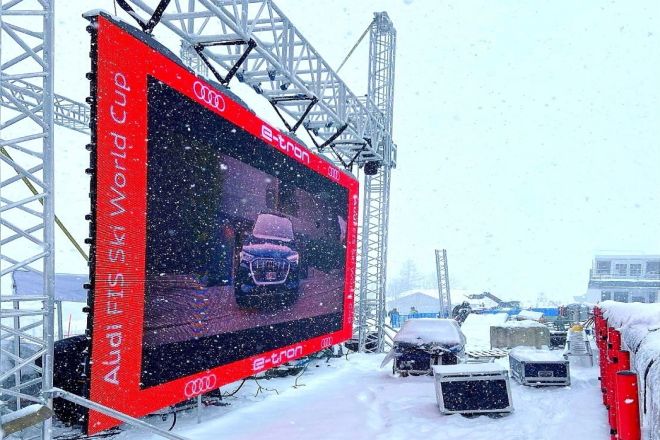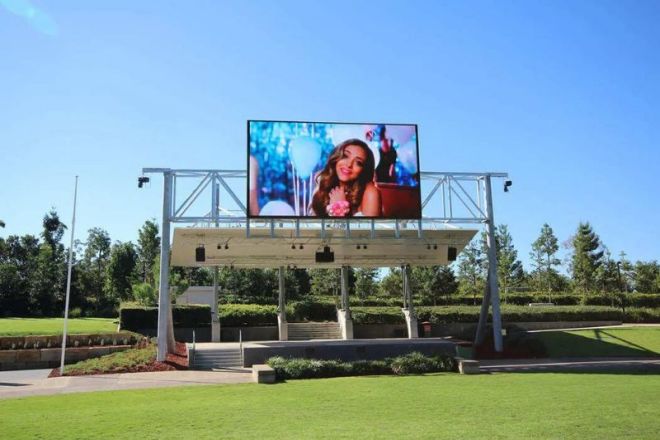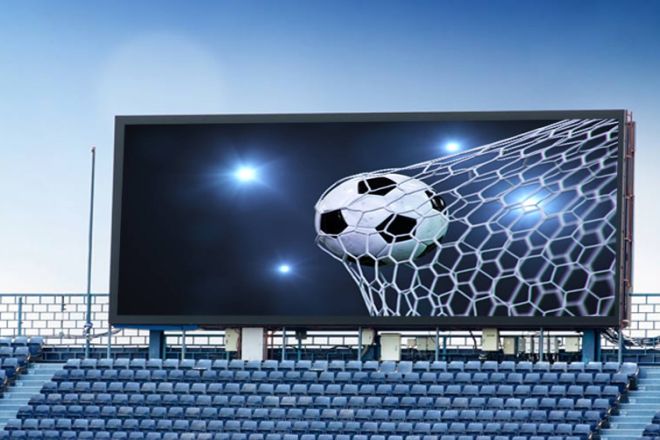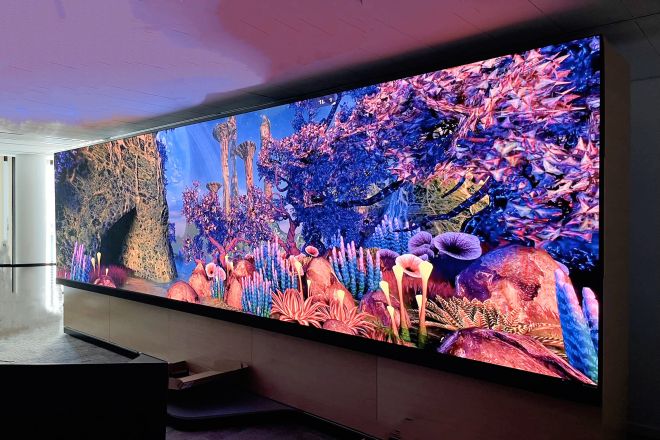Introduction

As an efficient, energy-saving, and environmentally friendly information display tool, LED display screens have been widely used in various fields, such as commercial advertising, sports events, public information release, etc., and have become an important medium for information transmission in modern society.
We have talked before about how to protect LED displays in hot areas. However, LED displays will also face a series of challenges and potential risks when operating in cold weather. So, this article will talk about what to do in severe cold weather.
1. The impact of cold weather on LED displays

LED display screens, as an important tool for modern information display, may suffer from a series of adverse effects when operating in cold weather. Below, we will use more popular language to explain these effects in detail so that even people who do not understand professional terminology can understand.
1). Display effect deteriorates
- Insufficient brightness:
On cold days, you may find that the LED display does not look as bright as it does in the summer. This is because the luminous efficiency of LED lamp beads decreases at low temperatures, just like a light bulb may not glow as brightly on a cold day as it does on a warm day. In this way, the displayed content may not be clear enough, especially on a sunny day, making it more difficult to read the words or images on the screen.
- Color Inaccuracies:
Colors may vary. For example, an originally set red may look more purple or pink. This is because the color temperature of the LED display tends to shift at low temperatures, just like the color of the sky you see in winter and summer may be different. This is because the seasons affect the color temperature.
- The picture is not smooth:
When you see the content on the screen switching, you may feel some lag or delay. This is because low temperatures cause the electronic components inside the display to respond more slowly, just as a person’s movements may become sluggish in cold weather.
2). Increased circuit risk
- Water droplets cause short circuits:
On cold days, water vapor in the air may condense inside the display, forming water droplets. If these water droplets fall on the circuit board, just like water entering the inside of the appliance, they may cause a short circuit or corrosion in the circuit, making the display unable to work properly.
- Current leakage:
Low temperatures can also cause the insulating material inside the display to degrade. It’s like in winter; some materials may become more conductive, causing current leakage or short circuits, increasing the risk of display damage.
3). structural changes
- Material shrinkage:
In cold weather, the display material may shrink due to the drop in temperature. Just like wood may shrink in the winter, if the material of your display shrinks unevenly, it could cause the screen to warp or crack.
- Broken connectors:
The metal connectors inside the display may break due to thermal expansion and contraction in cold weather. This is just like metal becoming more brittle and hard in cold weather and prone to breaking. If the connection breaks, parts of the display may not function properly.
2. Main points for cold weather maintenance of LED display screen

In cold weather, the maintenance of LED displays becomes particularly important. If proper maintenance is not carried out, the display may malfunction due to low temperature, condensation, and other problems, affecting the use effect. So, how should you maintain it?
1). Strengthen thermal insulation and wear “warm clothes” for the display
In cold weather, we need to put on “warm clothes” for the LED display, that is, take some insulation measures to prevent the impact of low temperature on the display.
First, you can add insulation materials to the outside of the display, such as an insulation cover or insulation layer. These materials can effectively block the invasion of cold air and maintain the temperature inside the display. Just like we add curtains or thermal insulation film to windows in winter, it is all to reduce the entry of cold air.
Secondly, you can also use a heater to provide warmth to the display. These heaters can be installed inside or around the display screen to increase the temperature of the display screen. This is just like how we use heaters or electric heaters for heating at home, both to create a warm environment.
2). Waterproof and moisture-proof, keeping the display away from “flood.”
In cold weather, water vapor in the air easily condenses into water droplets. If these water droplets enter the inside of the display, they may cause circuit short circuits or corrosion. Therefore, waterproofing and moisture-proofing are also very important.
First, you need to regularly check the sealing performance of the display. If it is found that the seal is not tight or there are gaps, it should be dealt with in time to prevent moisture from penetrating. This is just like how we regularly check whether the waterproofing layer of our house is intact to prevent flooding.
Secondly, you can also use waterproof materials and waterproof technology to enhance the waterproof performance of the display. For example, during the production and installation process of the display screen, we can use materials such as waterproof sealant and waterproof tape to ensure that the waterproof performance of the display screen is optimal.
3). Regular maintenance and inspections to keep the display in optimal condition
In addition to insulation, waterproofing, and moisture-proofing, regular maintenance and inspection are also key to ensuring the stable operation of LED displays in cold weather.
First, you need to clean the surface of your display regularly. Since there is a large amount of dust and impurities in the air, these substances may adhere to the display screen and affect its display effect. Therefore, we can use a soft cloth and special cleaner to wipe the display surface to ensure it is clean and bright.
Secondly, you also need to regularly check the display hardware equipment, such as power cords, capacitors, etc. If these devices are found to be aged or damaged, they should be replaced or repaired in time. This is just like how we regularly check whether the electrical equipment in our home is functioning properly to ensure their safety and stability.
In addition, you also need to pay attention to the software system of the display screen. Regularly updating the software version can fix some known vulnerabilities and errors and improve the performance and stability of the display. At the same time, you also need to back up important data and settings to prevent unexpected data loss.
4). Improve power adaptability and make the display stronger
In cold weather, the stability of the power supply is also an important factor affecting the operation of the LED display. In order to ensure the normal operation of the display, we need to improve the adaptability of the power supply.
First, you can use a constant current source power supply. A constant current source can ensure that the current output of the power supply is stable and reduce display failure caused by power supply fluctuations. This is just like using a regulated power supply to power electrical appliances, both to ensure that the electrical appliances can work stably.
Secondly, you can also add a power supply filter. The power filter can effectively filter out clutter and interference signals in the power supply and improve the quality of the power supply. This is just like we use a water purifier to filter impurities in tap water, all in order to obtain a purer and more stable water source.
5). Backup system preparation to deal with emergencies
Finally, in order to ensure the continuous operation of the LED display in cold weather, you also need to be prepared to back up the system.
The backup system includes key equipment such as a backup power supply and backup controller. When the main system fails, you can quickly switch to the backup system to ensure the normal operation of the display. This is just like installing a backup of important files in our computer so that we can quickly restore data and work status when unexpected situations occur.
3. Precautions

Regular cleaning: Use a soft, dry cloth to wipe the display surface. Avoid using cleaners containing chemical ingredients to prevent damage to the display surface.
Check the connecting cables and interfaces: Regularly check whether the connecting cables and interfaces of the display are secure to prevent signal transmission problems caused by looseness or poor contact.
Heat dissipation management: Ensure that the display’s heat dissipation system is working properly to prevent performance degradation or equipment damage caused by poor heat dissipation.
Back up important data: Regularly back up the display’s control system data and important configurations to prevent accidental loss.
Conclusion
The above is all the content of this article. Have you learned how to maintain LED displays in cold weather?
If you want to know more about LED displays, please contact us!
